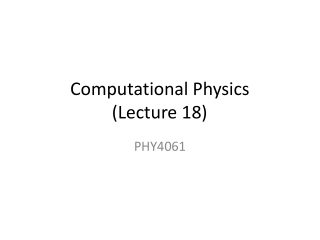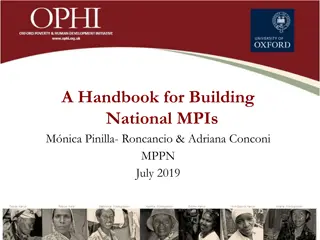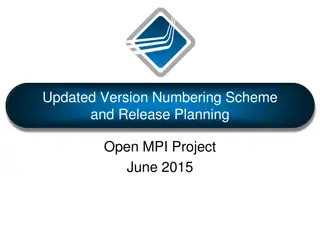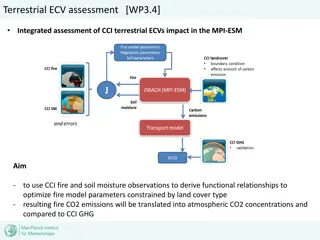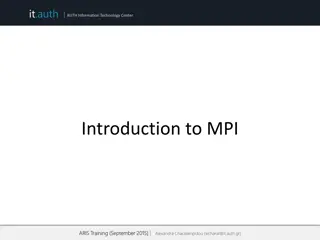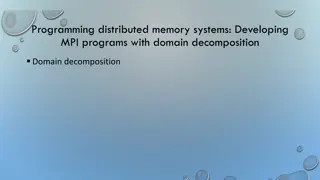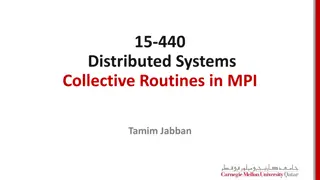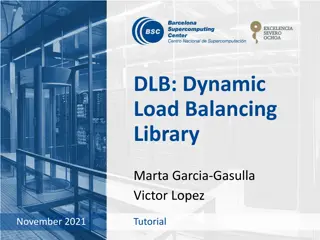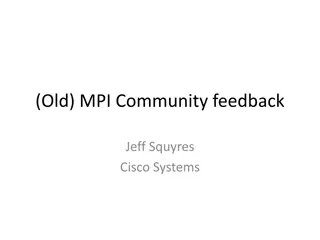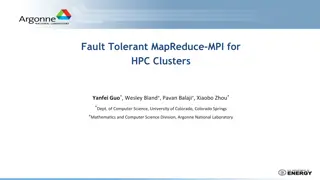
MPI Programming: Deriving Datatypes for Parallel Computing
Explore the concept of MPI derived datatypes for efficient parallel programming, focusing on necessary data transfers, local data structure communication, introduction to datatypes in MPI, predefined datatypes, and examples of derived datatypes. Learn about MPI_Type_contiguous and how to utilize it in creating arrays of datatypes effectively.
Download Presentation

Please find below an Image/Link to download the presentation.
The content on the website is provided AS IS for your information and personal use only. It may not be sold, licensed, or shared on other websites without obtaining consent from the author. If you encounter any issues during the download, it is possible that the publisher has removed the file from their server.
You are allowed to download the files provided on this website for personal or commercial use, subject to the condition that they are used lawfully. All files are the property of their respective owners.
The content on the website is provided AS IS for your information and personal use only. It may not be sold, licensed, or shared on other websites without obtaining consent from the author.
E N D
Presentation Transcript
Parallel Programming with MPI (MPI is the Message Passing Interface) CS 475 By Dr. Ziad A. Al-Sharif Based on the tutorial from the Argonne National Laboratory https://www.mcs.anl.gov/~raffenet/permalinks/argonne19_mpi.php
Necessary Data Transfers Provide access to remote data through a halo exchange (5 point stencil) 3
The Local Data Structure Communicating with contiguous data Edge element may be stored non-contiguously Manually packing and unpacking by bx 4
Introduction to Datatypes in MPI Datatypes allow to (de)serialize arbitrary data layouts into a message stream Networks provide serial channels Same for block devices and I/O Several constructors allow arbitrary layouts Recursive specification possible Declarative specification of data-layout what and not how , leaves optimization to implementation (many unexplored possibilities!) Choosing the right constructors is not always simple 5
Simple/Predefined Datatypes Equivalents exist for all C, C++ and Fortran native datatypes C int MPI_INT C float MPI_FLOAT C double MPI_DOUBLE C uint32_t MPI_UINT32_T Fortran integer MPI_INTEGER For more complex or user-created datatypes, MPI provides routines to represent them as well Contiguous Vector/Hvector Indexed/Indexed_block/Hindexed/Hindexed_block Struct Some convenience types (e.g., subarray) 6
Derived Datatype Example 0 1 2 3 4 5 6 7 8 9 10 11 12 13 14 15 16 17 18 19 20 21 22 23 contig contig contig indexed vector struct 7
MPI_Type_contiguous MPI_Type_contiguous(int count, MPI_Datatype oldtype, MPI_Datatype *newtype) Contiguous array of oldtype Should not be used as last type (can be replaced by count) 0 1 2 3 4 5 6 7 8 9 10 11 12 13 14 15 16 17 18 struct struct struct 1 0 1 1 contig 0 1 2 3 4 5 6 7 8 9 contig 8
MPI_Type_vector MPI_Type_vector(int count, int blocklen, int stride, MPI_Datatype oldtype, MPI_Datatype *newtype) Specify strided blocks of data of oldtype Very useful for Cartesian arrays 1 0 1 1 0 1 2 3 4 5 6 7 8 9 0 1 2 3 4 5 6 7 8 9 10 11 12 13 14 15 16 17 18 19 20 vector struct struct struct struct vector 9
Commit, Free, and Dup Types must be committed before use Only the ones that are used! MPI_Type_commit may perform heavy optimizations (and will hopefully) MPI_Type_free Free MPI resources of datatypes Does not affect types built from it MPI_Type_dup Duplicates a type Library abstraction (composability) 10
Use Datatype in Halo Exchange contig (count=bx, MPI_DOUBLE, ) or count with MPI_DOUBLE by vector (count=by, blocklen=1, stride=bx+2, MPI_DOUBLE, ) bx 11
Exercise 1: Stencil with Derived Datatypes (1/2) In the basic version of the stencil code Used nonblocking communication Used manual packing/unpacking of data Let s try to use derived datatypes Specify the locations of the data instead of manually packing/unpacking What datatype do we need here? by What datatype do we need here? bx 12
Exercise 1: Stencil with Derived Datatypes (2/2) Nonblocking sends and receives Data location specified by MPI datatypes Manual packing of data no longer required Start from nonblocking_p2p/stencil.c Solution in derived_datatype/stencil.c 13
MPI_Type_create_hvector MPI_Type_create_hvector(int count, int blocklen, MPI_Aint stride, MPI_Datatype oldtype, MPI_Datatype *newtype) Create byte strided vectors Useful for composition, e.g., vector of structs stride = 11 bytes 0 1 2 3 4 5 6 7 8 9 10 11 12 13 14 15 16 17 18 19 struct struct struct struct stride = 3 oldtypes hvector vector 14
MPI_Type_create_indexed_block MPI_Type_create_indexed_block(int count, int blocklen, int *array_of_displacements, MPI_Datatype oldtype, MPI_Datatype *newtype) Pulling irregular subsets of data from a single array dynamic codes with index lists, expensive though! blen=2 displs={0,5,8,13,18} 0 1 2 3 4 5 6 7 8 9 10 11 12 13 14 15 16 17 18 19 20 Indexed_block 15
MPI_Type_indexed MPI_Type_indexed(int count, int* array_of_blocklens, int *array_of_displacements, MPI_Datatype oldtype, MPI_Datatype *newtype) Like indexed_block, but can have different block lengths blen={1,1,2,1,2,1} displs={0,3,5,9,13,17} 0 1 2 3 4 5 6 7 8 9 10 11 12 13 14 15 16 17 18 19 20 indexed 16
MPI_Type_create_struct MPI_Type_create_struct(int count, int *array_of_blocklens, int *array_of_displacements, MPI_Datatype *array_of_types, MPI_Datatype *newtype) Most general constructor, allows different types and arbitrary arrays (also most costly) 0 1 2 3 4 struct 17
MPI_Type_create_subarray MPI_Type_create_subarray(int ndims, int* array_of_sizes, int *array_of_subsizes, int *array_of_starts, int order, MPI_Datatype oldtype, MPI_Datatype *newtype) Convenience function for creating datatypes for array segments (0,0) (0,1) (0,2) (0,3) (1,0) (1,1) (1,2) (1,3) Specify subarray of n-dimensional array (sizes) by start (starts) and size (subsize) (2,0) (2,1) (2,2) (2,3) (3,0) (3,1) (3,2) (3,3) 18
MPI_BOTTOM and MPI_Get_address MPI_BOTTOM is the absolute zero address Portability (e.g., may be non-zero in globally shared memory) MPI_Get_address Returns address relative to MPI_BOTTOM Portability (do not use & operator in C!) Very important to int a = 4; float b = 9.6; MPI_Datatype struct; build struct datatypes If data spans multiple arrays MPI_Get_address(&a, &disps[0]); MPI_Get_address(&b, &disps[1]); MPI_Type_create_struct(count, blocklens[], disps, oldtypes[], &struct); 19
Other DDT Functions Pack/Unpack Mainly for compatibility to legacy libraries You should not be doing this yourself Get_envelope/contents Only for expert library developers Libraries like MPITypes1 make this easier MPI_Create_resized Change extent and size (dangerous but useful) http://www.mcs.anl.gov/mpitypes/ 20
Datatype Selection Order Simple and effective performance model: More parameters == slower predefined < contig < vector < index_block < index < struct Some (most) MPIs are inconsistent But this rule is portable Advice to users: Try datatype compression bottom-up W. Gropp et al.: Performance Expectations and Guidelines for MPI Derived Datatypes 21
Section Summary Derived datatypes are a sophisticated mechanism to describe ANY layout in memory Hierarchical construction of derived datatypes allows them to be just as complex as the data layout is More complex layouts require more complex datatype constructions Current state of MPI implementations might be a bit lagging in performance, but it is improving Increasing amount of hardware support to process derived datatypes on the network hardware If the performance is lagging when you try it out, complain to the MPI implementer, don t just stop using it! 22

